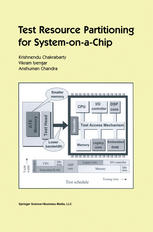

Most ebook files are in PDF format, so you can easily read them using various software such as Foxit Reader or directly on the Google Chrome browser.
Some ebook files are released by publishers in other formats such as .awz, .mobi, .epub, .fb2, etc. You may need to install specific software to read these formats on mobile/PC, such as Calibre.
Please read the tutorial at this link: https://ebookbell.com/faq
We offer FREE conversion to the popular formats you request; however, this may take some time. Therefore, right after payment, please email us, and we will try to provide the service as quickly as possible.
For some exceptional file formats or broken links (if any), please refrain from opening any disputes. Instead, email us first, and we will try to assist within a maximum of 6 hours.
EbookBell Team

5.0
68 reviewsTest Resource Partitioning for System-on-a-Chip is about test resource partitioning and optimization techniques for plug-and-play system-on-a-chip (SOC) test automation. Plug-and-play refers to the paradigm in which core-to-core interfaces as well as core-to-SOC logic interfaces are standardized, such that cores can be easily plugged into "virtual sockets" on the SOC design, and core tests can be plugged into the SOC during test without substantial effort on the part of the system integrator. The goal of the book is to position test resource partitioning in the context of SOC test automation, as well as to generate interest and motivate research on this important topic.
SOC integrated circuits composed of embedded cores are now commonplace. Nevertheless, There remain several roadblocks to rapid and efficient system integration. Test development is seen as a major bottleneck in SOC design, and test challenges are a major contributor to the widening gap between design capability and manufacturing capacity. Testing SOCs is especially challenging in the absence of standardized test structures, test automation tools, and test protocols.
Test Resource Partitioning for System-on-a-Chip responds to a pressing need for a structured methodology for SOC test automation. It presents new techniques for the partitioning and optimization of the three major SOC test resources: test hardware, testing time and test data volume.
Test Resource Partitioning for System-on-a-Chip paves the way for a powerful integrated framework to automate the test flow for a large number of cores in an SOC in a plug-and-play fashion. The framework presented allows the system integrator to reduce test cost and meet short time-to-market requirements.